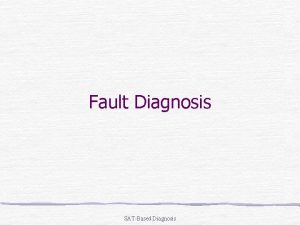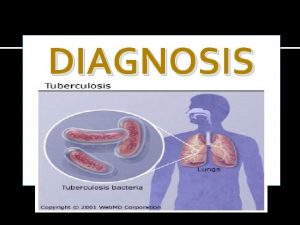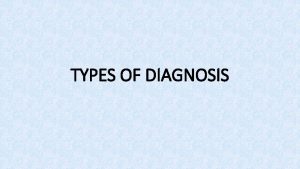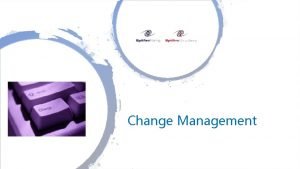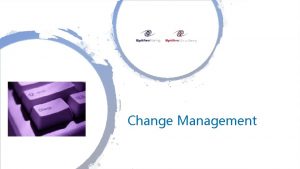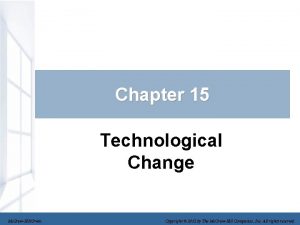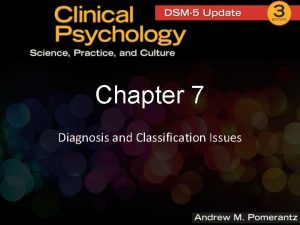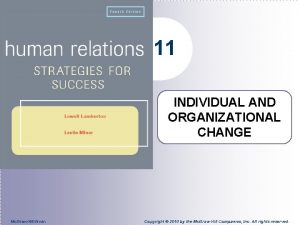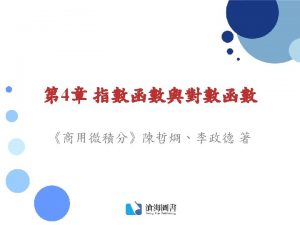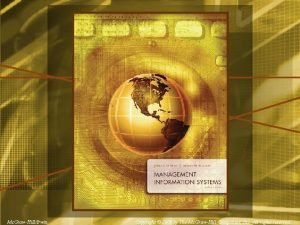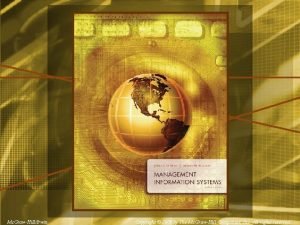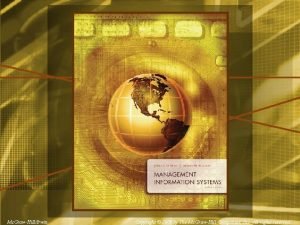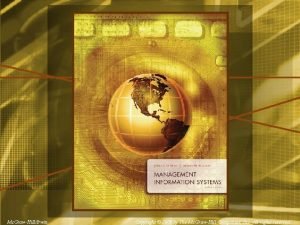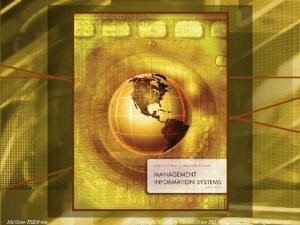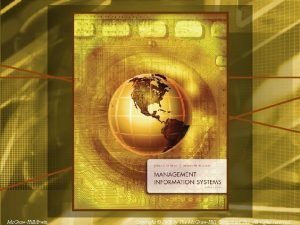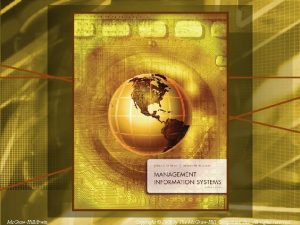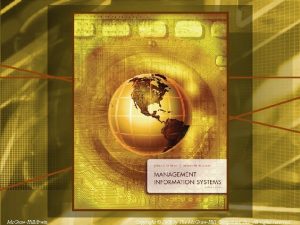Chapter 5 Diagnosis for Change Mc GrawHillIrwin Copyright























- Slides: 23

Chapter 5 Diagnosis for Change Mc. Graw-Hill/Irwin Copyright © 2009 by The Mc. Graw-Hill Companies, Inc. All rights reserved.

Diagnostic Tools Images of Managing Change Advantages of diagnostic tools Diagnostic Models: -Organization -Components • The image of the change manager has an impact on the types of tools that may be used. • The different images highlight the range of reasons why tools like these may be utilized – they illustrate the numerous ways change can be interpreted. Readiness for Change 5 -2

Images of Managing Change Diagnostic Tools Images of Managing Change Advantages of diagnostic tools Diagnostic Models: -Organization -Components Readiness for Change Images Diagnostic Tools Director Using diagnostic tools to build up your own knowledge base and confidence about what needs to change by using models that specify relationships among variables and pinpoint where change is needed when things are not going well. Navigator You will find the diagnostic tools attractive; models are ways of “mapping” the environment they describe. Caretaker You will be less convinced of the capacity of the diagnostic tools to support radical change, but several of the tools (see, e. g. , PESTEL and scenario analysis) provide insights into the trends in the external environment that you will have to take into account. Coach You will focus on the diagnostic tools that highlight the goals being sought and the competencies needed to attain them Interpreter You will be attracted to the diagnostic tools that emphasize images, framing, and cognitive maps Nurturer Having an interest in emergent strategy, you may remain unconvinced as to the value of such diagnostic tools. 5 -3

Advantages of Diagnostic Tools Images of Managing Change Advantages of diagnostic tools Diagnostic Models: -Organization -Components Readiness for Change • Simplify a complex situation. • Identify priorities for attention. • Highlight interconnectedness of various organizational properties (e. g. , strategy and structure). • Provide a common “language” with which to discuss organizational characteristics. • Provide a guide to the sequence of actions to take in a change situation. 5 -4

Diagnostic Models: Organization • Seven Models – – – – Six-box 7 -S Star Congruence Burke-Litwin Four-Frame Diagnosis by image 5 -5

Diagnostic Models: Organization • Six-box organizational model: – The key focus here is on six variables – purpose, structure, rewards, helpful mechanisms, relationship and leadership. – This model is useful to maintain awareness of all areas for consideration even though one variable may be identified as the main area for attention.

Diagnostic Models: Organization • 7 -S framework: – The 7 -S framework: this focuses on seven key components that affect organizational effectiveness – structure, systems, style, staff, skills, strategy and superordinate goals. – The interconnectedness of these variables is vital to the success of change.

Diagnostic Models: Organization • Star model: – An organization is effective when the five components of organizational design – strategy, structure, processes and later capability, reward systems and people practices – are in alignment.

Diagnostic Models: Organization • Star model effects of misalignment

Diagnostic Models: Organization • Congruence model: The organization is broken down into four components – task, individuals, formal organizational arrangements and informal organisation. This is influenced by the context where the strategy is formulated and the output is then the performance of the organization. 5 -10

Diagnostic Models: Organization Burke-Litwin This model identifies the transformational – external environment, mission and strategy, leadership and organizational culture - and transactional sources of change.

Diagnostic Models: Organization • Four frames to conceptualize an organization – Structural – formal design. Hierarchy, process, systems, etc – human resource – attention is on the relationship btwn org and its members. – Political – participants interact in pursuit of a range of objectives. Some are in common, some differ. – Symbolic – culture, beliefs, values, rituals, meanings

Diagnostic Models: Organization • Diagnosis by image: – This technique allows organizational members to use images to describe the organizations and this can be used as a basis for discussion. – First: describe the organization – Next: keep adding more and more detail

Diagnostic Models: Components Diagnostic Tools Images of Managing Change • PESTEL Framework: – This analyses the external environment in terms of six factors – Political, Economic, Social, Technological, Environmental and Legal. Advantages of diagnostic tools Diagnostic Models: -Organization -Components Readiness for Change 5 -14

Diagnostic Models: Components • Scenario analysis: – Creating stories of possible future scenarios that are considered to be vital to the future of the organization • “Flight simulator” 1. 2. 3. 4. Brainstorm all important environmental factors Out of the factors, everybody identify “key drivers” of performance Aggregate responses, and rank the key drivers Using the key drivers, construct 3 scenarios of what will happen to the key drivers over time 1. Most likely 2. Pessimistic 3. Optimistic

Diagnostic Models: Components • Gap analysis – This is a tool used for reviewing the organization’s position based on where they are and where they want to get to. 1. 2. 3. • High Consensus? – • Where are we now? Where do we want to get to? How can we get there? Either close the gap, or wait for a competitor to the high concesus view Low consensus? – Pay more attention to the objectives of the org

Diagnostic Models: Components Elements of strategy These are five elements of strategy that are considered mutually reinforcing – arenas, vehicles, differentiators, staging and lowest costs through scale advantage. Any misalignment of these signifies the need for change.

Boundariless Organization • Speed, flexibility, and integration are “new success factors”, which are achieved by reducing boundaries: – Vertical – Horizontal – External – geographic

Diagnostic Models: Components Diagnostic Tools Images of Managing Change The Boundaryless Organization: – Success is arguably achieved only if four types of organizational boundaries are diagnosed and reduced. These are vertical, horizontal, external and geographical boundaries. Advantages of diagnostic tools Diagnostic Models: -Organization -Components Readiness for Change 5 -19

Readiness for Change Diagnostic Tools Images of Managing Change Advantages of diagnostic tools Diagnostic Models: -Organization -Components Readiness for Change • Assessing the organization's readiness to change can be a mediating variable between change management strategies and the outcomes of desired strategies. • A perchance audit of the readiness of an organization for change can provide an indication of the likely outcome of a change initiative at a particular point in time. Some ways of doing this include: – Questionnaires – Stakeholder analysis: This focuses on the position of stakeholders in the change process and allows the manager to be better informed of how to confront potential issues. – Force-field analysis: This identifies factors that are driving forces for change as well as restraining forces. 5 -20

Force Field Analysis • Looks at factors that can hinder or assist the change 5 -21

Stakeholder Analysis • Focuses on the position of key stakeholders – Who has power – Who will resist the most – How can support be gathered – How can resistance be reduce 5 -22

Exercise – Boeing Case • You will be given a model, for either conceptualizing the organization, or diagnosing the readiness for change 1. Make a brief presentation on the model 2. Apply the model to the case, making assumptions when needed 3. How did the model give you insight, or increase your understanding of the case? 4. In what ways would you enhance the model, to improve its suitability for the case?
 Dependent nursing interventions
Dependent nursing interventions Medical diagnosis and nursing diagnosis difference
Medical diagnosis and nursing diagnosis difference Nursing diagnosis three parts
Nursing diagnosis three parts Types of nursing diagnoses
Types of nursing diagnoses Perbedaan diagnosis gizi dan diagnosis medis
Perbedaan diagnosis gizi dan diagnosis medis Fspos vägledning för kontinuitetshantering
Fspos vägledning för kontinuitetshantering Typiska drag för en novell
Typiska drag för en novell Nationell inriktning för artificiell intelligens
Nationell inriktning för artificiell intelligens Vad står k.r.å.k.a.n för
Vad står k.r.å.k.a.n för Varför kallas perioden 1918-1939 för mellankrigstiden
Varför kallas perioden 1918-1939 för mellankrigstiden En lathund för arbete med kontinuitetshantering
En lathund för arbete med kontinuitetshantering Kassaregister ideell förening
Kassaregister ideell förening Personlig tidbok
Personlig tidbok Anatomi organ reproduksi
Anatomi organ reproduksi Densitet vatten
Densitet vatten Datorkunskap för nybörjare
Datorkunskap för nybörjare Tack för att ni lyssnade bild
Tack för att ni lyssnade bild Debattartikel struktur
Debattartikel struktur Magnetsjukhus
Magnetsjukhus Nyckelkompetenser för livslångt lärande
Nyckelkompetenser för livslångt lärande Påbyggnader för flakfordon
Påbyggnader för flakfordon Tryck formel
Tryck formel Publik sektor
Publik sektor I gullregnens månad
I gullregnens månad


























